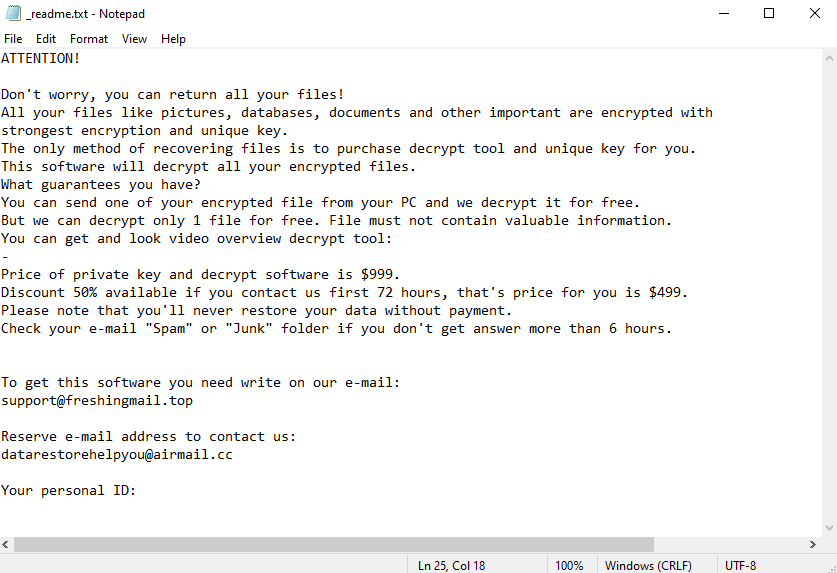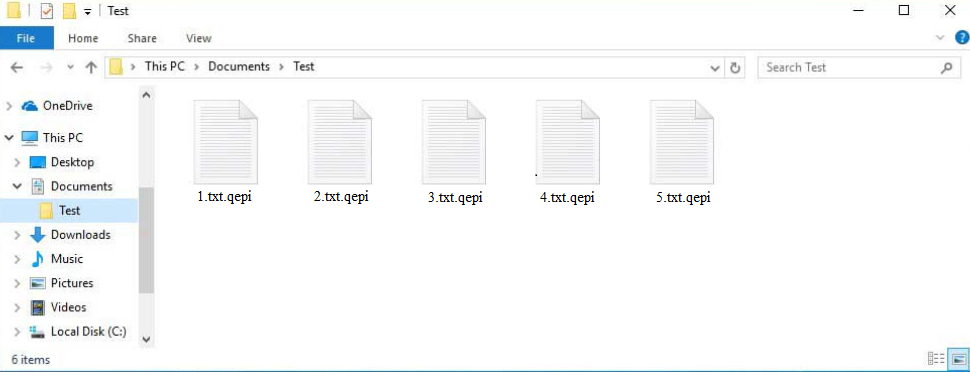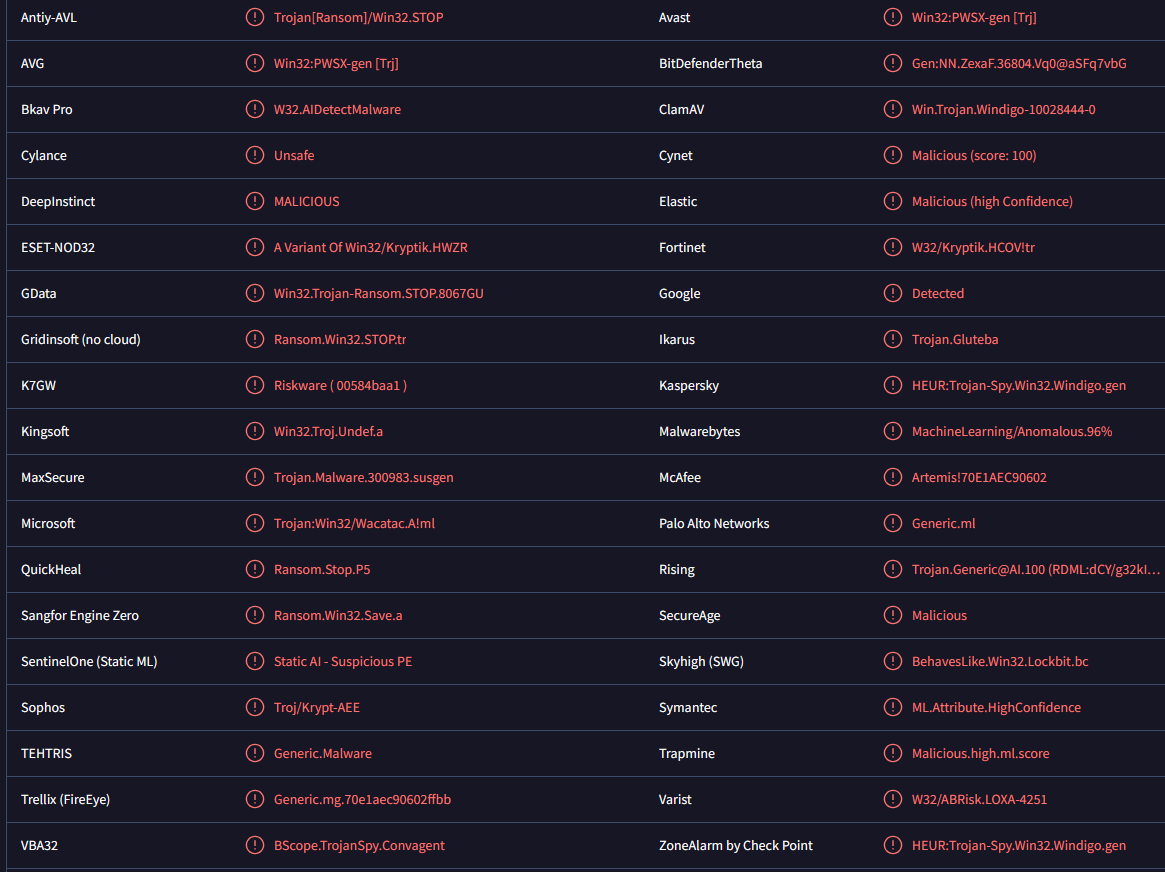How to delete Qepi ransomware
Qepi ransomware is malware that encrypts files. It belongs to the Djvu/STOP ransomware family, malware operated by a notorious group of cyber criminals who release new versions regularly. Infections from this family are classified as very dangerous because recovering encrypted files is not always possible. Only users who have backups of files are guaranteed file recovery.
The ransomware begins encrypting files as soon as it’s initiated. While it’s encrypting files, it shows a fake Windows update window. It’s meant to prevent users from noticing their files being encrypted. Unfortunately, the ransomware targets all personal files, which include photos, videos, documents, etc. These files are most important to users and they’re most willing to pay to get them back. Encrypted files will be very noticeable because file names will have a .qepi extension added to them. For example, an encrypted 1.txt file would become 1.txt.qepi. Files with that extension will not be openable unless they’re first decrypted using a special decryptor. However, this decryptor is not easily obtainable.
Qepi ransomware drops a _readme.txt ransom once it’s done encrypting files. The note explains how victims can get the decryptor, and unfortunately, it means paying a $999 ransom. According to the note, there’s supposedly a 50% discount if victims contact the malware operators within the first 72 hours. The cybercriminals also promise to decrypt one file for free as long as it does not contain any important information. However, paying the ransom or even contacting the cybercriminals is not recommended.
The fact that you will not necessarily get a decryptor after paying is one of the main reasons why giving in to the demands is not a good idea. Keep in mind that you are dealing with cybercriminals. They are not obligated to help victims and there’s nothing to force them. Many ransomware victims have paid money in the past only to not receive anything in return. The decision whether to pay or not is yours but you should be aware of the risks. We should also mention that the ransom money victims pay goes towards future criminal activities.
Below is the full Qepi ransomware ransom note:
ATTENTION!
Don’t worry, you can return all your files!
All your files like pictures, databases, documents and other important are encrypted with strongest encryption and unique key.
The only method of recovering files is to purchase decrypt tool and unique key for you.
This software will decrypt all your encrypted files.
What guarantees you have?
You can send one of your encrypted file from your PC and we decrypt it for free.
But we can decrypt only 1 file for free. File must not contain valuable information.
You can get and look video overview decrypt tool:
–
Price of private key and decrypt software is $999.
Discount 50% available if you contact us first 72 hours, that’s price for you is $499.
Please note that you’ll never restore your data without payment.
Check your e-mail “Spam” or “Junk” folder if you don’t get answer more than 6 hours.To get this software you need write on our e-mail:
support@freshingmail.topReserve e-mail address to contact us:
datarestorehelpyou@airmail.ccYour personal ID:
Users who have file backups can connect to them to recover files as soon as they remove Qepi ransomware from their computers. It’s strongly recommended to use a good anti-malware program to delete Qepi ransomware because it’s a complex infection that requires a professional program to get rid of. When it’s no longer detected by your anti-malware program, you can safely connect to your backup and start file recovery. If you do not have a backup, your options are very limited because you can only wait for a free Qepi ransomware to be released. However, a free Qepi ransomware decryptor is not guaranteed.
Ransomware distribution methods
Qepi ransomware is distributed via the usual methods, like email attachments, torrents, and malicious ads/links. If you have bad browsing habits, you’re much more likely to pick up a malicious infection. Developing better habits and becoming familiar with malware distribution methods is a good way to avoid future malware infections.
Malware operators commonly distribute malware via email attachments. Users whose email addresses have been leaked are considerably more likely to receive a malicious email. Fortunately, many malware-carrying emails are not difficult to identify as malicious because they are generic. The most noticeable thing about them is the grammar and spelling mistakes. The mistakes are very obvious because senders pretend to be from legitimate companies. For example, malicious emails are often disguised as parcel delivery notifications or order confirmations. Legitimate emails, especially automatic ones, are mistake-free because mistakes would look unprofessional.
How an email addresses you can also tell you a lot about whether it’s malicious/spam or not. For example, order confirmations or parcel delivery notifications use the names users provided during registration to address them. However, malicious emails target many users with the same email so they use generic words like “User”, “Member”, and “Customer” to address users. If an email is important enough for you to open its attachment, it will address you by name.
In some cases, when malicious actors target specific people, malicious emails look significantly more sophisticated. They use users’ names and include certain information to make the emails seem more credible. Thus, it’s recommended to always scan all unsolicited email attachments with anti-virus software or VirusTotal before opening them.
Malware is also distributed through torrents. Because torrent sites are often poorly moderated, torrents with malware are very common. It’s particularly common to find malware in torrents for entertainment content (e.g. movies, TV series, video games, etc.). Whether you pirate content is your choice but you should be aware that it’s not only content theft but also dangerous for your computer/data.
How to remove Qepi ransomware
You need to use a reliable anti-malware program to remove Qepi ransomware because it’s a complex infection. Manual Qepi ransomware removal could cause additional damage to your computer. Once the malware is gone, you can connect to your backup and start recovering files. If you do not have a backup, your only option is to wait for a free Qepi ransomware decryptor to be released. If it does get released, it will become available on NoMoreRansom.
Qepi ransomware is also detected as:
- Win32:PWSX-gen [Trj] by AVG/Avast
- A Variant Of Win32/Kryptik.HWZR by ESET
- Trojan:Win32/Wacatac.A!ml by Microsoft
- HEUR:Trojan-Spy.Win32.Windigo.gen by Kaspersky
- MachineLearning/Anomalous.96% by Malwarebytes
- Artemis!70E1AEC90602 by McAfee
Site Disclaimer
WiperSoft.com is not sponsored, affiliated, linked to or owned by malware developers or distributors that are referred to in this article. The article does NOT endorse or promote malicious programs. The intention behind it is to present useful information that will help users to detect and eliminate malware from their computer by using WiperSoft and/or the manual removal guide.
The article should only be used for educational purposes. If you follow the instructions provided in the article, you agree to be bound by this disclaimer. We do not guarantee that the article will aid you in completely removing the malware from your PC. Malicious programs are constantly developing, which is why it is not always easy or possible to clean the computer by using only the manual removal guide.



